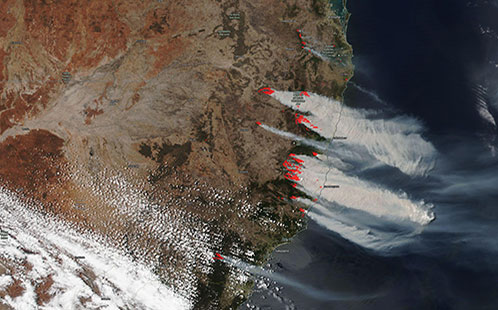Global analysis shows unprecedented scale of Australian summer of fire
 An unprecedented outbreak of large, intense fires stretched from the mid-north coast of New South Wales into central Queensland.
An unprecedented outbreak of large, intense fires stretched from the mid-north coast of New South Wales into central Queensland.
Researchers at Western Sydney University’s Hawkesbury Institute for the Environment have analysed historic data on the extent of Australia’s extraordinary forest fires and found that the area burned in Australia during the 2019-2020 forest fires far exceeds historic records worldwide.
Even in previous major fire years, only around two per cent of Australia’s temperate forests have burned. Yet in the summer of 2019/2020, an astounding 21 per cent of these forests have been burned, a figure far and above preceding historic records.
“We analysed the major forest biomes across Australia, Asia, Africa, Oceania and North and South Americas to determine the extent of annual areas burned by forest fires”, said Associate Professor Matthias Boer, lead author of the study and lead scientist of the NSW Bushfire Risk Management Research Hub node at Western Sydney University.
“Forests in Australia and other continents have historically burned up to approximately 5% of the forest area each year, with higher percentages of 8-9% only recorded in small forest regions of Africa and Asia. Yet in Australia’s 2019/2020 season, this burned area jumped to 21% of the total forest area in a single season.
“This is a globally unprecedented scale of burning, not observed in any other forest biome over the last 20 years”, Associate Professor Boer said.
Australia’s eucalypt-dominated forests are part of the Temperate Broadleaf and Mixed (TBLM) Forest Biome, which covers millions of hectares in Australia and other continents. They are among the most fire-prone forests on Earth, being shaped by fires that are triggered by occasional periods of drought and heat. In normal years, fires would burn mostly through dry litter on the ground and are kept in check by damp gullies and south-facing slopes that hinder the spread of fire and reduce the probability of mega forest fires.
However, after three years of extreme drought and driven by high temperatures and winds, fuel conditions were drier than ever recorded in 30 years, escalating fires ignited by lightning from dry thunderstorms that spread over millions of hectares from September 2019 onwards.
“Climate change predictions warned of higher temperatures, longer more widespread droughts and more extreme fire behaviours, and it seems that the future we feared has arrived sooner than expected”, said Associate Professor Boer.
This analysis was published as a Letter to the editor in Nature Climate Change.(opens in a new window)
ENDS
25 February 2020
Latest News

Opinion: What do we lose when our old suburbs disappear?
I live on the edge of Parramatta, Australia’s fastest-growing city.

Opinion: Most bees don’t die after stinging – and other surprising bee facts
Most of us have been stung by a bee and we know it’s not much fun. But maybe we also felt a tinge of regret, or vindication, knowing the offending bee will die. Right? Well, for 99.96% of bee species, that’s not actually the case.

Western Sydney University receives transformational donation to support LGBTIQA+ community
Western Sydney University has welcomed a philanthropic donation from The Brennan Lynch Foundation.
Mobile options:

